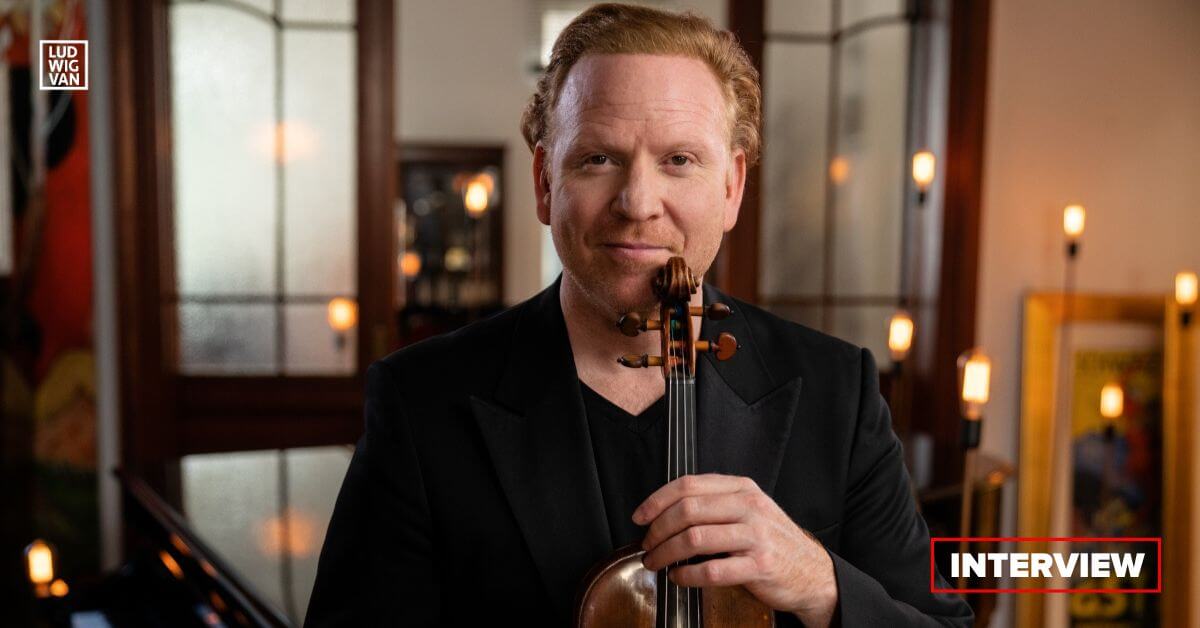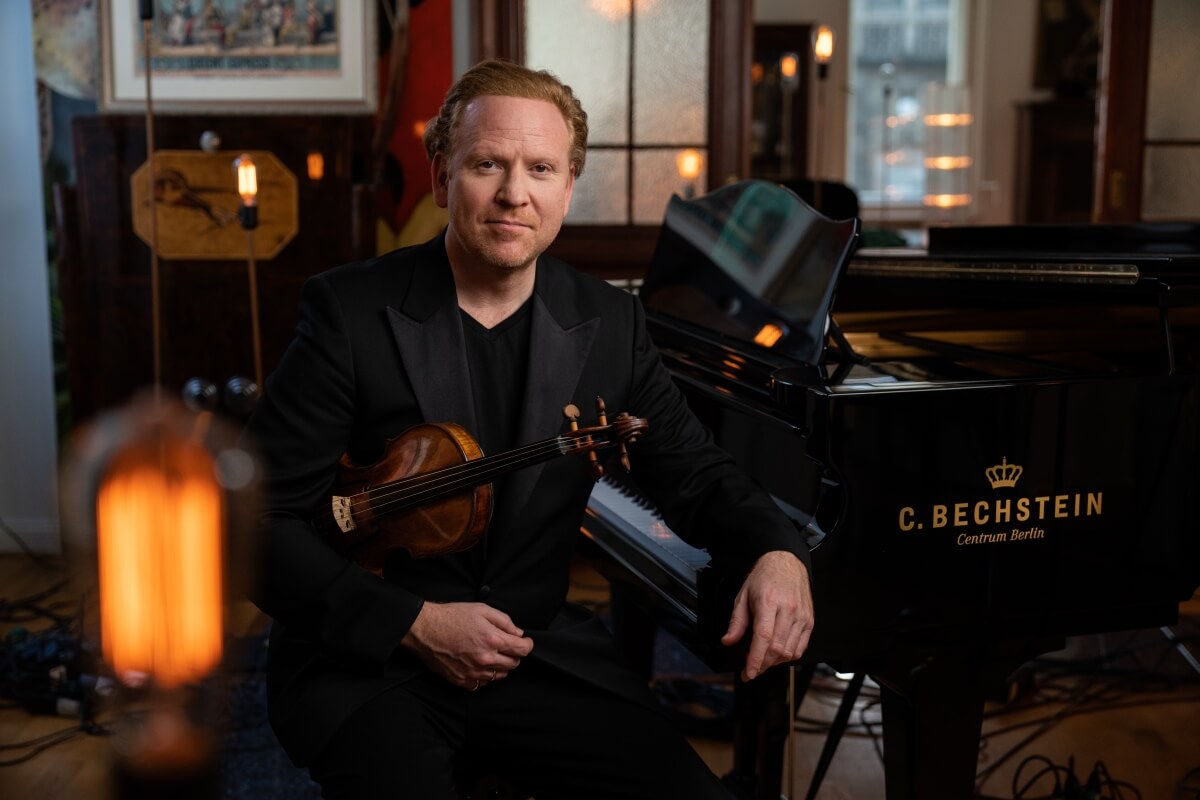
Violinist Daniel Hope has a best-selling album on the charts, and is on an international tour that he’s bringing to Toronto’s Koerner Hall on April 24. His North American tour features music from another album that will be released this summer.
Hope has carved out a unique career in the classical music world over the last 30 years or so. He’s appeared with many of the world’s most prominent orchestras, as well as performing as a soloist and chamber musician. He has been the Music Director of the Zurich Chamber Orchestra since 2016, and Music Director of San Francisco’s New Century Chamber Orchestra since 2018. In 2019, he added Artistic Director of the Frauenkirche Dresden to the list, and he has been President of the Beethoven-Haus in Bonn since 2020.
Through it, he’s combined musicality with a pursuit of thematic significance, and social relevance in his repertoire.

Daniel Hope
Daniel was born in South Africa, however, when he was about six months old, his family, known for its militant anti-apartheid activism, left the country on the condition they never return. The family found a home in Europe, first in Paris, then London, where his mother became Yehudi Menuhin’s secretary, then eventually manager. Daniel began his violin studies when he was about five.
His family originally hailed from Ireland. It was Hope’s great-grandfather Daniel McKenna who left Ireland about a century ago, eventually landing the family in South Africa. Hope holds an Irish passport, and has explored his roots in a documentary film.
During the pandemic, he also became known as a broadcaster with his hugely successful Hope@Home series.
Daniel Hope – Gardel: Por una cabeza (Live from Yellow Lounge, 2024):
Daniel Hope: Dance
The 2024 album’s tracks span centuries of music, all of it united by a focus on dance. The composers include Britten, Bartók, Shostakovich, Price, Schubert, Purcell, Stravinsky, and many, many more. The project is one that he has had on the backburner for a long time.
“It’s something that really has been with me for decades.”
It goes back to when he first began to make records, and he plotted out several projects and concepts. “Le danse”, as it was to be called, exploring the first 500 years of Western dance, was on his original list.
“I was always fascinated to find out where it came from,” he says. As he began to delve into the research, he realized that the dances of the early Renaissance were simply a continuation of a practice that went back tens and perhaps hundreds of thousands of years in history to the ancient Greeks and Romans and beyond.
“There was one point where someone sat down and notated it,” he says. Paintings and other artifacts point to a much longer history.
As a violinist, he sees a natural connection to dance. As he points out, violinists often served as the dance master in the late Renaissance and Baroque periods. With a mobile instrument, they led the tempo.
“I put, on the back of an envelope, about 25 years ago, this plan.”
Naturally, during the intervening years, the plan developed and changed. “I’ve changed,” he laughs. The project expanded from 500 to 700 years of repertoire, and from a single CD release to two. “The whole thing grew enormously,” he explains. “It was something that I’ve dreamed about making.”
It’s not only the music itself. It’s what it tells us about social history. “What I find so fascinating in researching this project is […] what dance meant.” He points out that class played a role, in that some dances were only allowed to be performed by the aristocracy.
On the other side of the class coin, some dances are associated with peasants celebrating the autumn harvests, or rituals that bring on rainfall. Dance can be ceremonial, performed to mark specific events.
“There are so many different ways that dance was used, and were protected in history.”
Many classical compositions take their inspiration from those more ancient roots. He points out that Saint-Saëns’ Danse Macabre, for example, is a 19th century take on a medieval concept, the dance of death. Some also connect to European colonialism and expansionism, such as the fandango, which many scholars believe to have been inspired Indigenous Americans, and brought back to Europe by the Spanish.
“There’s a highly political and historical aspect to many of these dances,” he says.
He reports that some 30,000 audience members have heard the repertoire performed live in Europe. “When you’re actually there, and I’m telling the stories of some of these pieces, […] people are really listening to the context. Some of them got up and danced,” he says. “It does open the communication from the stage.”
The concerts have gone well. “I would say in general, it’s been received extremely well.” It’s a bit of an understatement. The album reached No. 1 and No. 2 in German lists. “The response has just been overwhelming. I’m very, very lucky that I’m able to make these productions with a huge number of musicians from all over the world,” he says. “It was a massive project to put together […] when it all happens, you don’t know how they’ll like it.”
Daniel Hope at Koerner Hall: Irish Roots
For his North American concert dates, including Toronto and Montreal, he’s bringing repertoire from a new album that will drop this summer. The program for the Koerner Hall recital is titled Irish Roots, and delves into the history of Irish music, a topic that’s close to his heart.
“Going back all these years ago, it’s also been on my list,” he says.
Dance music figures prominently, albeit not exclusively, in the mix. “There are of course dances and jigs in that,” he says. “It’s very, very exciting.”
In his research into the traditional music of the island he discovered many pieces. The music of Ireland also tells a story about social history.
“The tremendous history in Ireland, and the conflicts that took place over five or six centuries produced some […] very tragic events, and of course, changed the course of life there.” The music includes protest songs and true Irish folk music of the 18th and 19th centuries.
The works include a long list of traditional pieces, and pieces focusing on Irish composers from the late Renaissance to the late Baroque, along with those of Central European composers who drew inspiration from Ireland,
Irish Traditional:
- “Cooley’s”
- “Seán Frank”
- “Fair and Forty”
- “The One-Horned Cow”
- “Patsy Jouhey’s”
- “Killavil Jig”
Various composers:
- Thomas Roseingrave: Introduction to Scarlatti’s Lessons (arr. Olivier Fourès)
- Thomas Roseingrave: Gavotte from Fifth Set (arr. Fourès)
- Henry Purcell: A New Irish Tune, Z. 646
- Domenico Scarlatti: Sonata in B Minor, K. 27 (arr. Fourès)
- Domenico Scarlatti: Sonata in D Minor, K. 141 (arr. Fourès)
- Johann Sigismund Kusser: Arias from Erindo oder Die unsträfliche Liebe (arr. Fourès)
- Francesco Geminiani: Auld Bob Morrice
- James Oswald: “She’s Sweetest When She is Naked”
- James Oswald: “Scotsman Over the Border”
- James Oswald: “Murray’s March”
- Irish Traditional: “The Minor Bee”
- Antonio Vivaldi: Allegro from L’estro armónico, op. 3, Concerto No. 5
- Antonio Vivaldi: Prelude from Trio Sonata in D Major, op. 1, no. 8, RV 64
- Antonio Vivaldi: Allegro from Violin Concerto in B Minor, RV 387 (“Slip Jig”)
- Turlough O’Carolan: “O’Carolan’s Devotion”
- Turlough O’Carolan: “O’Carolan’s Concerto”
Irish Traditional:
- “Codladh an Óighir” (arr. Siobhán Armstrong)
- “The Waterford Walz”
- “The Red Haired Boy”
- “Coey’s Hornpipe”
- “Pingneacha Rúa agus Prás”
- “Dublin Streets”
- “Dever the Dancer”
- “Connaughtman’s Ramble”
- “The Humors of Castel Bernard”
Daniel Hope will be performing with his AIR ensemble, made up of hand-picked musicians. Along with the music, Daniel will share the myths and legends of Ireland.

The Future
“I’ve been making quote unquote concept albums now for some 25 years. When I first started to make them, nobody wanted to hear them,” he says. He agrees that, in recent years, streaming and playlists have helped to make thematic releases like his more popular.
“Sometimes projects take a while to come to fruition.”
From recent experience, Hope reports that crowds in Europe have come back, and seem to appreciate the music perhaps even more than before the pandemic. “It’s tremendous, and humbling,” he says. “In Germany, we’ve seen a complete return.” In some cases, audience levels exceed pre-COVID numbers. “The big concert halls are full.”
But, it’s not a time when anyone in the classical music industry can stop and become complacent.
“More than ever, we have to keep up the pressure, and keep up the energy.”
- Find out more about the April 24 concert in Toronto, and tickets, [HERE].
Are you looking to promote an event? Have a news tip? Need to know the best events happening this weekend? Send us a note.
#LUDWIGVAN
Get the daily arts news straight to your inbox.
Sign up for the Ludwig Van Toronto e-Blast! — local classical music and opera news straight to your inbox HERE.
- PREVIEW | SUMMER OPERA LYRIC THEATRE Presents Handel’s Xerxes, Mozart’s Idomeneo & Puccini’a La Boheme July 26 To August 4 - July 26, 2024
- PREVIEW | YENSA Festival V.2 Offers Black Flames Performances & Other Ways To Celebrate Black Women In Dance - July 25, 2024
- PREVIEW | Canadian Talent Conspicuous In The Met: Live In HD 2024-25 Season - July 25, 2024



